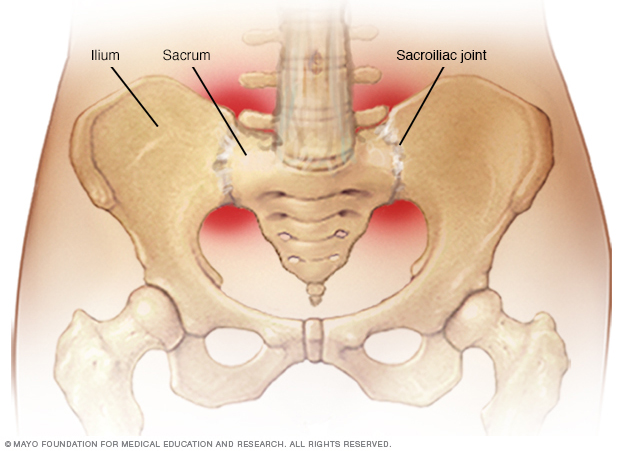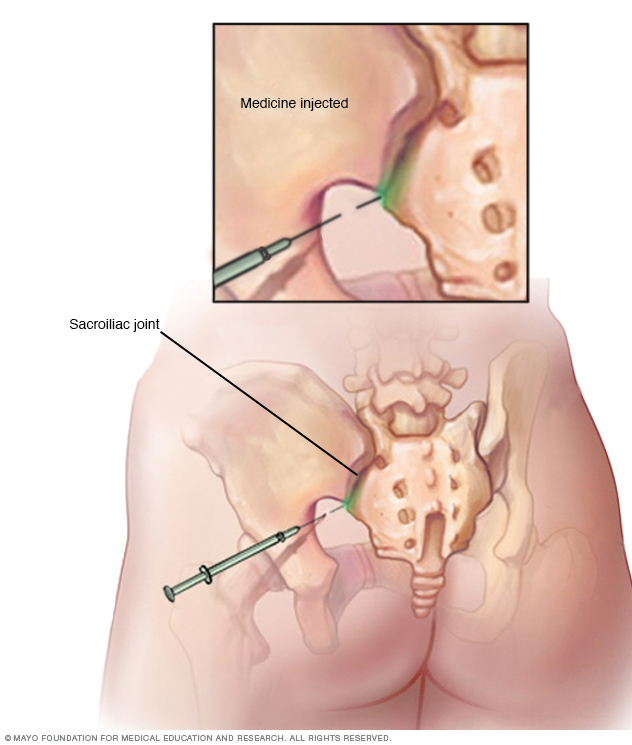Overview
Sacroiliitis (say-kroe-il-e-I-tis) is a painful condition that affects one or both sacroiliac joints. These joints sit where the lower spine and pelvis meet. Sacroiliitis can cause pain and stiffness in the buttocks or lower back, and the pain might go down one or both legs. Standing or sitting for a long time or climbing stairs can make the pain worse.
Sacroiliitis can be hard to diagnose. It can be mistaken for other causes of low back pain. It's been linked to a group of diseases that cause inflammatory arthritis of the spine. Treatment might involve physical therapy and medicines.

Symptoms
The pain of sacroiliitis most often occurs in the buttocks and lower back. It also can affect the legs, groin and even the feet. The pain can improve with movement. The following can make sacroiliitis pain worse:
- Sleeping or sitting for a long time.
- Standing a long time.
- Having more weight on one leg than the other.
- Stair climbing.
- Running.
- Taking large steps when moving forward.
Causes
Causes for sacroiliac joint issues include:
- Injury. A sudden impact, such as a motor vehicle accident or a fall, can damage the sacroiliac joints.
- Arthritis. Wear-and-tear arthritis, also known as osteoarthritis, can occur in sacroiliac joints. So can a type of arthritis that affects the spine, known as ankylosing spondylitis.
- Pregnancy. The sacroiliac joints loosen and stretch for childbirth. The added weight and changed way of walking during pregnancy can stress these joints.
- Infection. Rarely, a sacroiliac joint can become infected.
Risk factors
Certain conditions may increase the risk of swelling in the sacroiliac joints.
Inflammatory forms of arthritis, such as ankylosing spondylitis and psoriatic arthritis, may increase the risk of sacroiliitis. Inflammatory bowel diseases, including Crohn's disease and ulcerative colitis, also may increase the risk.
Changes that happen to the body during pregnancy and childbirth also can stress the sacroiliac joints and cause pain and swelling.
Complications
Sacroiliitis can cause difficulty with certain actions, such as bending, lifting, staying in one position and rising from being seated. The ongoing pain of sacroiliitis can lead to depression and loss of sleep.
Diagnosis
During the physical exam, a health care provider might press on the hips and buttocks to find the pain. Moving legs into different positions gently stresses the sacroiliac joints.
Imaging tests
An X-ray of the pelvis can show signs of damage to the sacroiliac joint. An MRI can show whether the damage is the result of ankylosing spondylitis.
Numbing shots
If putting numbing medicine into the sacroiliac joint stops the pain, it's likely that the issue is in the sacroiliac joint.
Treatment
Treatment depends on symptoms and the cause of the sacroiliitis. Stretching and strengthening exercises and nonsteroidal antiinflammatory pain relievers you can get without a prescription are often the first treatments used.
Medicines
Depending on the cause of the pain, these might include:
- Pain relievers. Nonsteroidal antiinflammatory pain relievers you can get without a prescription include ibuprofen (Advil, Motrin IB, others) and naproxen sodium (Aleve). If these don't provide enough relief, a health care provider might prescribe a stronger pain reliever.
- Muscle relaxers. Medicines such as cyclobenzaprine (Amrix) might help reduce the muscle spasms that often go along with sacroiliitis.
-
Biologics. Biologic medicines treat many autoimmune conditions. Interleukin-17 (IL-17) inhibitors include secukinumab (Cosentyx) and ixekizumab (Taltz). Tumor necrosis factor (TNF) inhibitors include etanercept (Enbrel), adalimumab (Humira), infliximab (Remicade) and golimumab (Simponi).
Both types of biologics are used to relieve sacroiliitis.
- Disease-modifying antirheumatic drugs (DMARDs). DMARDs are medicines that decrease swelling, known as inflammation, and pain. Some target and block an enzyme called Janus kinase (JAK). JAK inhibitors include tofacitinib (Xeljanz) and upadacitinib (Rinvoq).
Therapy
A health care provider, such as a physical therapist, can teach range-of-motion and stretching exercises. These exercises are designed to ease pain and to keep the low back and hips more flexible. Strengthening exercises help protect the joints and improve posture.
Surgical and other procedures
If other methods haven't relieved pain, a health care provider might suggest:
- Shots into the joint. Corticosteroids can be put into the joint to reduce swelling and pain. You can get only a few joint injections a year because the steroids can weaken nearby bones and tendons.
- Radiofrequency denervation. Radiofrequency energy can damage or destroy the nerve causing the pain.
- Electrical stimulation. Implanting an electrical stimulator in the lower spine might help reduce pain caused by sacroiliitis.
- Joint fusion. Although surgery is rarely used to treat sacroiliitis, fusing the two bones together with metal hardware can sometimes relieve sacroiliitis pain.

Lifestyle and home remedies
Home treatments for sacroiliitis pain include:
- Pain relievers you can get without a prescription. Medicines such as ibuprofen (Advil, Motrin IB, others) and acetaminophen (Tylenol, others) may help relieve the pain of sacroiliitis. Some of these medicines can cause stomach upset, or kidney or liver problems.
- Rest. Changing or not doing the activities that worsen pain might help. Using good posture is important.
- Ice and heat. Switching between ice and heat might help relieve sacroiliac pain.
Preparing for an appointment
You might start by seeing your primary care provider. You might be referred to a specialist in bones and joints, known as a rheumatologist, or an orthopedic surgeon.
What you can do
Take a family member or friend along, if possible. Someone who's with you can help you remember the information you get.
Make a list of:
- Your symptoms and when they began.
- Key information, including recent life changes and whether any first-degree relative has had symptoms like yours.
- All medicines, vitamins or other supplements you take, including doses.
- Questions to ask your care provider.
For sacroiliitis, questions to ask include:
- What's likely causing my symptoms?
- What are other possible causes?
- What tests do I need?
- Is my condition likely temporary or chronic?
- What's the best treatment?
- How can I manage this condition with my other health conditions?
- Are there restrictions I need to follow?
- Should I see a specialist?
- Are there brochures or other printed materials I can have? What websites do you recommend?
Ask other questions you have.
What to expect from your doctor
Your care provider might ask you questions, such as:
- Have your symptoms been continuous or occasional?
- Where exactly is the pain? How bad is it?
- Does anything make the pain better? Does anything make it worse?
© 1998-2025 Mayo Foundation for Medical Education and Research (MFMER). All rights reserved. Terms of Use


